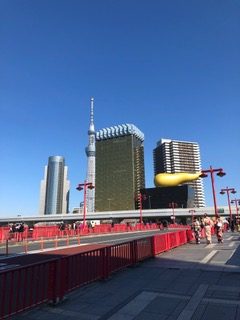When I looked up Karinto on wikipedia, it said it was Japanese sweets. If you think about it like Japanese sweets and think of Karinto, it seems strange to think that it is Japanese sweets.
Kakinotane(Japanese famous snack) are Japanese sweets. There is no discomfort. What about Imagawa Yaki? It will be Japanese sweets. What about rice cracker? This is definitely Japanese sweets.
Then, when I remember Karinto (its shape and taste) again, I felt that something more uncomfortable than before. Is Karinto really Japanese sweets?
In addition to its origin, Karinto has another mystery.
When I went around the Tohoku region for a week last year, what shocked me most was that the shape of karinto varied from region to region.
In the middle part of Japan, Karinto is a short stick and tastes of black sugar.
In Tohoku (Akita), it has triangular shape and thin strips.
In the Kansai area, thinking that Karinto is a swirl like Begoma (shell shaped top).
In this way, Karinto, which has evolved and developed independently in various forms throughout the country like Darwin’s finches, no one knows when it came to Japan from, origin of its name or whether it was born in Japan.
Karinto is a sweet that surely exists even if its origin is unknown. weird.
Reading “The World of Encyclopedia Wagashi” by Keiko Nakayama, explains Karinto as
“Mixed flour with starch syrup, kneaded, fried in oil, and honeyed confectionery”
It’s a beautiful explanation that’s summed up with 5/7/5/7/7 sounds(In Japanese). When I read ahead while thinking about such extraneous things, “Tang confectionery(means come from Tang) is associated with the method of frying flour with dough as oil, but the one with the same name has not been found” “It looks like Konpeito(other confectionary came from Europe) , There is no record as a Nanban confectionery.”
Tang confectionery and Nanban confectionery are well known as confectionery that came to Japan 1300 years ago and have an influence on Japanese confectionery today.
Tang confectionery was introduced to Japan by the Ambassador from Tang during the Asuka period, and the Nanban confectionery was brought in from Spain and the Netherlands after the provincial wars period. It is said that today’s Japanese sweets have evolved through fusion with ancient Japanese sweets (mochi, dango, etc.) that originally developed independently, and also influenced by the culture of Kamakura and Edo.
Apparently, the origin of Karinto is that I’m skeptical about Tang confectionery. This is because in Nara prefecture, there is “Buto”, one of the Tang confectionery introduced to Japan during the Asuka period. “Buto” is a sweet that is shaped like dumplings and kneaded with rice flour. “At Kasuga Taisha Shrine, you make “Buto” for the gods and offer them at each festival.”
Imagine that this was the origin of Karinto.
You can easily make sweets like “Buto” while changing the raw material to cheaper wheat flour. It has become popular as a confectionary and spread around the Kinki region in the Edo period. After it was distributed to the Kanto region, it spread to the Tohoku region by being stretched or chopped into small pieces. I wonder. So even though the Karinto from Kinki to Chubu is sweet, in the Tohoku region it may have been arranged with soy sauce or sprinkled with sesame seeds.
Speaking of which, Akita also has spicy karinto, which uses chile pepper for seasoning, which was a surprise for those from the Chubu region who only know sweet black sugar karinto. It seems that the confectionery from Tang was reunited in a foreign land after a long time (I don’t know how long it was) with its compatriots while changing its shape.
No, I didn’t know the origin of the name, but if the sound of eating it came from, I think it was good that it didn’t become Balintow or Palinto. It’s a bit wild or too pop. After all, I think Karinto fits nicely.
Personally, I feel a little happiness when I bite the occasional black honey rather than Karinto itself.
Looking back at my writing, I found that pepper was not from China during the Tang dynasty, and the earliest theory is that it was in 1552 or 1542 (Sengoku period). It is said that the Portuguese brought it to Japan. The name at that time was Nanban pepper. The “Tang” simply means that they come from abroad.
When I was wondering if they had reunited with a friend from the same country in Akita, a romantic punch line that was a fateful encounter between strangers that came all the way from foreign countries. researching is discovering.

